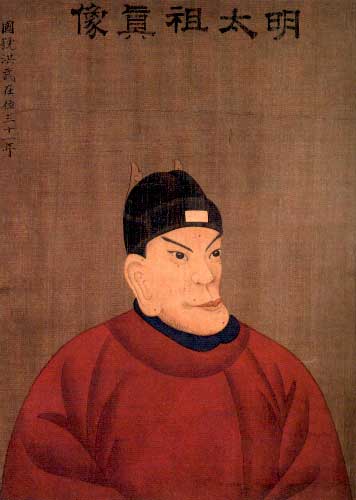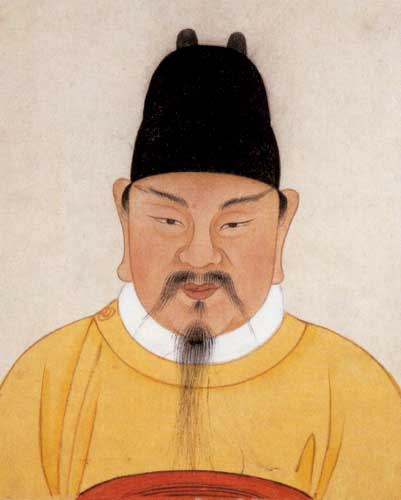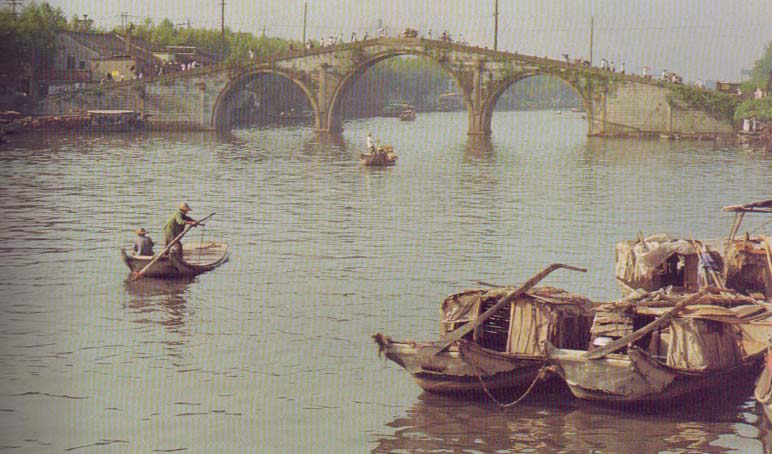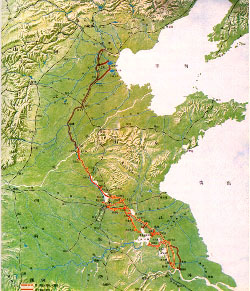Ming2
Summing up WINTER
With the founding of
the Ming the period of destruction related to the rebellions that ended the
Mongol Yuan dynasty gave way to a time of consolidation of the state visible in
the reconstruction of agriculture and administration.
The end of the Yuan
saw a rapid inflation, corruption of the Tibetan clergy who controlled the
Chinese clergy and interfered in political affairs, and rebellions of the
exploited Chinese population against Mongol and other foreign officials.
One of the rebellions
attracted the poor monk Zhu Yuanzhang (1328-1398)
who later became the head of a rebel army and successfully fought against
the Mongols as well as other contenders for power.
 The Hongwu emperor, Zhu Yuanzhang
The Hongwu emperor, Zhu Yuanzhang
The Ming dynasty may
be divided into four larger periods:
1. 1368- 1450: The age
of economic reconstruction and installation of new institutions. Diplomatic
and military expansion were pursued in
 The Yongle emperor, Zhu Di
The Yongle emperor, Zhu Di
2. 1450-1520: A period
of withdrawal and defence after the great expeditions. This period in the
eyes of orthodox Confucians was a time in which commerce disrupted the cycle
of agriculture and began to corrupt society. The polarization of the wealthy
and the poor began.
3. 1520-ca.1580: A 2nd
Chinese ‘renaissance’ among Chinese intellectuals during the rules of emperors Zhengtong and Zhengde could not
avert the growing imbalance of agriculture and commerce. Agriculture, so the orthodox
Confucians, was neglected, commerce dominated the
economy. The purity of working the land gave way to the excesses related to the
influence of capital.
Consumption, not
necessity, began to drive production.
4. 1580-1644: a
period of crises in commerce, politics, and revolts among urban workers
Phase I:
Society in the initial century of the Ming was characterized by a search for
stability through reconstruction of the agrarian social system (which had
been abandoned as early as the Song when a commercial revolution had propelled
the economy) and at the same time created physical and social immobility while
the population more than doubled.
► Agriculture:
restoration and reclamation of land
reforestation
transfer of immigrants to new territories, land
distribution
► Physical
immobility:
Travel was
discouraged. The maximum radius of travel in which no route certificate was
required was a distance of 58 km.
Transgression of this
law was punished (at times by capital punishment) at the time of return.
► Social
immobility:
Occupations were
hereditary. (This regulation actually had first been introduced by the Mongols
and belongs to those regulations that the first Ming emperor, Hongwu, did not discard instantly.)
The society consisted
of
• peasants
who had to settle in villages,
• artisans
who worked in state-service workshops,
• merchants
who were only allowed to perform trade in necessities,
• and
soldiers who were settled at the frontiers in large numbers.
• A small educated
elite whose members were generally more distrusted than trusted by emperor
Hongwu, managed the administration of the empire.
► A rural idyll was propagated:
Families had a house
to live in, land to cultivate in the predictable rhythm of the annual cycle of agriculature, hills with trees for firewood, gardens to
grow vegetables. Taxes were appropriate. Life was secure due to the absence of
bandits and military attacks. Moral values were kept high through a functioning
marriage and family system.
► Registration
for purposes of tax collection:
Households were registered
in official charts. In order to recruit household members for duty in the
labor service system, units of 10 households were combined to one ‘tithing’
(jia),
headed by a ‘tithing head’ whose position rotated annually;
units of ten tithings
were combined to a ‘hundred’ (li), headed by a ‘hundred captain’; his position rotated on
a decade basis.
‘Tithings’,
‘hundreds’, and their heads were supervised by six tax captains selected by the
local administration.
Mobility would
have distorted and in fact later did distort the systematic registration of
the population for tax purposes. In the beginning of the Ming, physical mobility
was only supported and at times required for
► creating
new settlements in the border regions in order to control military activities
of the neighboring peoples or states and
► creating a
new social fabric in the cities especially in the metropolitan areas when
households of former opponents of contenders for power were sent into exile as
settlers of territories that were to be newly cultivated. The population was
functionally divided and distributed.
► Uniformity in
official matters
Due to the loss/
transformation of state ritual and etiquette during the Yuan Dynasty uniformity
was required in costume and in handling official matters.
Models for writing
memorials were published. These models enabled not only educated officials but
also less educated commoners to formulate their ideas and concerns in an
officially accepted standardized fashion.
Memorials could be
handed in by commoners who -at least in one case transmitted to us- could
impeach a magistrate.
Each memorial that
was sent in had to be duplicated. The original was sent directly to the emperor
who wrote a statement and sent memorial and statement to the Office of
Supervising Secretaries. The office was created in the Ming and solely in
charge of handling memorials. It received the duplicate and matched it with the
original and the emperor’s statement. Every memorial was recorded in the
official Court Record. A handwritten summary was published in the Beijing
Gazette which also informed its readers about promotions, demotions, military
and diplomatic affairs, as well as news from the provinces such as natural
disasters etc.
When the Veritable
Records (Shilu)
were composed at the end of a rulers’ reign, the Gazette was one
of the sources on which the Shilu
were based.
► Officially approved physical mobility
was supervised by the Ministry of War which
managed
the courier service,
the postal service, and
the transport service.
Courier stations were
established every 35 to 45 km. They kept up to 450 horses and mules, and 50-60
sedan chairs (which had been introduced as a means of transportation during the
Yuan Dynasty) and the necessary amount of carriers.
The
47.004 full-time
laborers were in charge of maintaining the


Means of
transportation
horse, mule
sedanchair
wheelbarrow (max. load: 120 kg)
4 wheel mule-cart
(max. load: 3000 kg /375 km)
grain barge (average max. load 30.000 kg) made
of pine (exchange: every 5 years) or made of the more durable fir wood
(exchange: every 10 years)
Brook argues that
the tension created by the search for social stability caused the trend of
economic growth. Regional and national commercial networks were formed. Agriculture
developed from producing the means for subsistence to a production of surplus
which could be traded. The production of commodities used the improvements
in infrastructure provided by the newly consolidated state for its tax goods.
Mobility necessarily increased.
On an international
level the states roaming the ‘